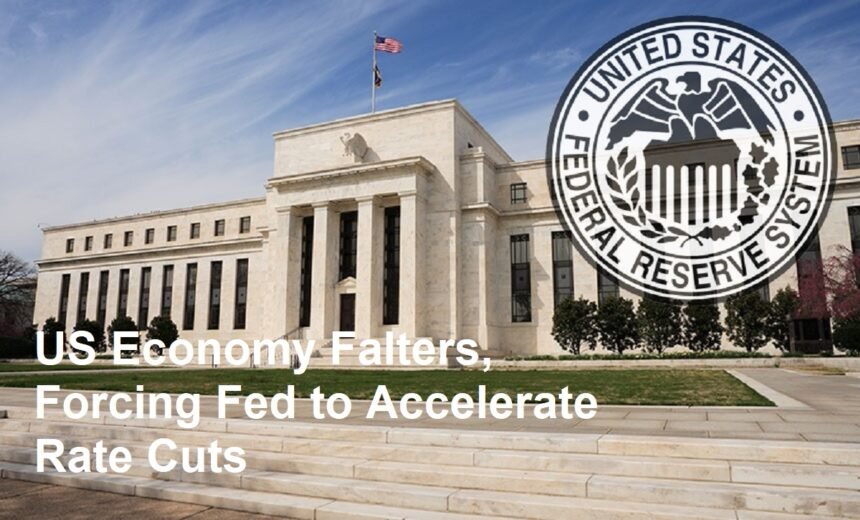Introduction
A palpable chill has settled over the US economy in mid-2025, prompting the Federal Reserve to make a decisive and accelerated shift in monetary policy. Faced with mounting evidence of a significant slowdown, the central bank is moving faster and deeper on interest rate cuts than many anticipated just months ago, marking a stark reversal from its prolonged “higher for longer” stance aimed at taming inflation.
Signs of Growing Weakness
Several key indicators have converged, painting a picture of an economy losing steam:
- Stalling GDP Growth:Economic expansion has noticeably downshifted. After a weak first quarter, preliminary data for Q2 2025 suggests near-zero or even slightly negative growth. Business investment has softened considerably, and consumer spending, while resilient for so long, is finally showing cracks under the weight of accumulated inflation and tighter credit.
- Cooling Labor Market:The once red-hot job market is cooling rapidly. While unemployment remains relatively low historically, the trend is concerning. Job gains have slowed significantly, job openings have declined, and initial unemployment claims are ticking upwards. Wage growth, a key inflation driver, is also moderating faster than expected.
- Persistent Manufacturing Slump:The manufacturing sector continues to contract, with key indices like the ISM Manufacturing PMI languishing in contractionary territory. Weak global demand and high domestic borrowing costs are taking a toll.
- Softening Consumer Sentiment:Measures of consumer confidence have retreated. Concerns about the economic outlook, job security, and the high cost of living are causing households to become more cautious with their spending, a critical headwind for a consumer-driven economy.
- Disinflation Progress:Crucially, while the Fed’s primary mandate includes maximum employment, the significant progress made on inflation (bringing it much closer to the 2% target from its multi-decade highs) has provided the necessary breathing room to prioritize supporting growth.
The Fed’s Accelerated Response
Faced with this deteriorating landscape, the Federal Reserve is pivoting aggressively:
- Faster Pace:Having likely initiated its first cut in late 2024 or early 2025, the Fed is now increasing the pace of reductions. What was expected to be a gradual, quarter-point-per-meeting glide path is accelerating, potentially involving larger (e.g., 50 basis point) cuts or cuts at consecutive meetings.
- Deeper Cuts:The projected “terminal rate” for this cutting cycle is being revised downwards significantly. Forecasts suggesting rates might settle around 3.5% are being replaced with expectations dipping towards 3% or even lower by the end of 2025 or early 2026, reflecting the perceived depth of the economic weakness.
- Forward Guidance Shift:The Fed’s communication has undergone a dramatic change. Gone is the cautious, data-dependent language emphasizing inflation risks. Instead, statements now clearly prioritize supporting economic activity and employment, explicitly citing the increased downside risks to growth. Phrases like “act as appropriate to sustain the expansion” are central.
Why the Rush? Fear of Something Worse
The Fed isn’t cutting rates faster simply because growth is slowing; it’s cutting because it sees risks of a more pronounced downturn or even a recession materializing:
- Credit Crunch Concerns:Past rate hikes work with a lag. The full impact of significantly higher borrowing costs for businesses and consumers may only now be biting hard, potentially triggering a sharper pullback in lending and spending than anticipated.
- Global Weakness:Sluggish growth in key trading partners (Europe, China) dampens US export prospects and adds to the headwinds.
- Preemptive Action:The Fed aims to be preemptive. By acting decisively now, it hopes to cushion the fall, boost confidence, and prevent a mild slowdown from spiraling into a deeper, more damaging recession. Waiting too long risks having to cut even more aggressively later, potentially with less effect.
Market Reactions and Implications
- Equity Markets:Stocks have rallied strongly on the prospect of cheaper money, particularly rate-sensitive sectors like technology and housing.
- Bond Markets:Treasury yields have fallen sharply across the curve, reflecting expectations of lower rates and a weaker growth/inflation outlook. The yield curve is likely steepening as short-term rates fall faster.
- US Dollar:The dollar has weakened significantly against major currencies as the interest rate differential favoring the US narrows rapidly.
- Housing Market:Mortgage rates are falling, providing some relief to the housing sector, though affordability remains a challenge.
- Global Central Banks:The Fed’s move pressures other major central banks (like the ECB and BoE) to potentially accelerate their own easing cycles, especially if their economies are also slowing and inflation is moderating. This could provide broader global stimulus.
- Emerging Markets:Easier US monetary policy generally relieves pressure on emerging markets by weakening the dollar and potentially encouraging capital flows towards higher-yielding assets.
Risks and the Path Ahead
The Fed’s gamble is not without risks:
- Inflation Resurgence:Cutting rates aggressively while inflation, though lower, is still above target (especially in services) could risk reigniting price pressures, forcing a difficult policy reversal later.
- Asset Bubbles:Excessively easy money could fuel unsustainable rallies in risk assets like stocks or real estate.
- Limited Ammunition:Significantly lower rates leave the Fed with less room to cut if a severe recession hits later.
Conclusion
The US economic landscape in mid-2025 is defined by palpable weakness, compelling the Federal Reserve to abandon its cautious approach and accelerate interest rate cuts. This aggressive pivot reflects deep concerns about stalling growth, a cooling labor market, and the rising risk of a more significant downturn. While offering potential relief to markets and borrowers, this strategy carries inherent risks, primarily the possibility of undermining hard-won progress against inflation or fostering financial instability. The Fed is clearly betting that the immediate threat of economic stagnation outweighs these longer-term concerns, prioritizing a swift intervention to shore up growth and avert a deeper crisis. The effectiveness of this accelerated easing will be the defining economic story of the latter half of 2025.












